Renewable Electric Energy Storage Systems by Storage Spheres on the Seabed of Deep Lakes or Oceans
Abstract
:1. Introduction
2. Working Scheme of a U.PSH
3. Experimental Test of the U.PSH—The StEnSea Project
4. Proposals of Other Schemes of U.PSH
4.1. Storage Carrier U.PSH for Offshore Energy Storage
4.2. U.PSH in Flooded Open Cast Coal Mining Pits
- The wall plus possible inner construction parts plus sub-construction plus upper dome should be made from concrete, thick enough to withstand the 40 bar ambient pressure.
- The buoyancy can be compensated by the weight of the concrete structure itself or by added ballast like sand or gravel.
- Since concrete is rather cheap and easy to process (climbing or sliding formwork), all bulky parts should be made of concrete where possible.
- The shape of each segment should render the optimal net storage volume.
- The turbine plus shut-off valve must be movable in one piece to the surface for maintenance.
- The installation should be low-priced, safe and fast.
- The technology is based on the well-proven concept of an arch dam, which for many decades and all over the world has been standard for reservoirs with stable rock supports.
- However, in the case of the ring dam wall, no pushing away of the structure by water pressure is possible as the ring is evenly exposed to the water pressure from all sides so that the displacement forces cancel each other out. Thus, for the ring arch dam, “stable mountain flanks” are no longer necessary.
- Because the reservoir enclosed by the ring dam wall is open at the top, no lid with supports, pillars and domes is necessary.
- The inside of the ring dam wall represents the air side of a reservoir. There are no buoyancy problems, which people know from experience with the many reservoirs all over the world.
- Exploitation of a large range of level difference between the basins. The level in the deep inner reservoir, which is optically hidden from the outside, can be varied in an extraordinarily wide range. This suggests the use of pump turbines connected in series, which can be placed at different heights on the dam wall to avoid excessive inlet pressure. In the course of a storage cycle, at least a large proportion of the pump turbines can be used in different configurations by means of variable parallel and series connections, resulting in good utilization of the pump turbines.
- Additional storage space at the bottom (Figure 14, area 37). From the business of open pit mining, big machines digging deep holes for moving the soil and extracting lignite are now available, enabling cost-effective storage space at the bottom of the ring dam wall reservoir to be produced.
5. Conclusions
Author Contributions
Funding
Data Availability Statement
Acknowledgments
Conflicts of Interest
References
- Sterner, M.; Stadler, I. (Eds.) Handbook of Energy Storage-Demand, Technologies, Integration; Springer GmbH: Berlin, Germany, 2019; 844p, ISBN 978-3-662-55503-3. [Google Scholar]
- Brown, T.W.; Bischof-Niemz, T.; Blok, K.; Breyer, C.; Lund, H.; Mathiesen, B.V. Response to ‘Burden of proof: A comprehensive review of the feasibility of 100% renewable-electricity systems’. Renew. Sustain. Energy Rev. 2018, 92, 834–847. [Google Scholar] [CrossRef]
- Hansen, K.; Mathiesen, B.V.; Skov, I.R. Full energy system transition towards 100% renewable energy in Germany in 2050. Renew. Sustain. Energy Rev. 2019, 102, 1–13. [Google Scholar] [CrossRef]
- Ruhnau, O.; Qvist, S. Storage requirements in a 100% renewable electricity system: Extreme events and inter-annual variability. Environ. Res. Lett. 2022, 17, 044018. [Google Scholar] [CrossRef]
- Gyuk, I. DOE Global Energy Storage Database, Sandia National Laboratories. 2021. Available online: https://sandia.gov/ess-ssl/gesdb/public/index.html (accessed on 22 September 2021).
- Shan, R.; Reagan, J.; Castellanos, S.; Kurz, S.; Kittner, N. Evaluating emerging long duration energy storage technologies. Renew. Sustain. Energy Rev. 2022, 159, 112240. [Google Scholar] [CrossRef]
- Akinyele, D.O.; Rayudu, R.K. Review of energy storage technologies for sustainable power networks. Sustain. Energy Technol. Assess. 2014, 8, 74–91. [Google Scholar] [CrossRef]
- Brown, T.; Hampp, J. Ultra-Long-Duration Energy Storage Anywhere: Methanol with Carbon Cycling. Joule 2023, 7, 2414–2420. [Google Scholar] [CrossRef]
- Bundesnetzagentur: Data Archive SMARD. 2023. Available online: https://www.smard.de/home/downloadcenter/download-marktdaten/ (accessed on 31 January 2023).
- Luther, G.; Schmidt-Böcking, H. The Role of Short-Term Storage Like Hydropower in Abandoned Opencast Mines in the Energy Transition. In 791. WE-Heraeus-Seminar (2023)/The Physical, Chemical and Technological Aspects of the Fundamental Transition in Energy Supply from Fossil to Renewable Sources—Key Aspect: Energy Storage, Lecture 11.1. Available online: http://www.fze.uni-saarland.de/AKE_Archiv/AKE2023_Heraeus.Sp/Vortraege/AKE2023-H.Sp_11.1_Luther_Role.ofShortTermStorage_PSKW.imTagebauloch.pptx (accessed on 15 December 2022).
- Ulvestad, A. A Brief Review of Current Lithium Ion Battery Technology and Potential Solid State Battery Technologies. arXiv 2018, arXiv:1803.04317. [Google Scholar]
- Redondo-Iglesias, E.; Venet, P.; Pelissier, S. Efficiency Degradation Model of Lithium-Ion Batteries for Electric Vehicles. IEEE Trans. Ind. Appl. 2019, 55, 1932–1940. [Google Scholar] [CrossRef]
- Smith, K.; Saxon, A.; Keyser, M.; Lundstrom, B.; Cao, Z.; Roc, A. Life prediction model for grid-connected Li-ion battery energy storage system. In Proceedings of the 2017 American Control Conference (ACC), Seattle, WA, USA, 24–26 May 2017. [Google Scholar]
- Amirthan, T.; Perera, M.S.A. The role of storage systems in hydrogen economy: A review. J. Nat. Gas Sci. Eng. 2022, 108, 104843. [Google Scholar] [CrossRef]
- King, M.; Jain, A.; Bhakar, R.; Mathur, J.; Wang, J. Overview of current compressed air energy storage projects and analysis of the potential underground storage capacity in India and the UK. Renew. Sustain. Energy Rev. 2021, 139, 110705. [Google Scholar] [CrossRef]
- Aghahosseini, A.; Breyer, C. Assessment of geological resource potential for compressed air energy storage in global electricity supply. Energy Convers. Manag. 2018, 169, 161–173. [Google Scholar] [CrossRef]
- Swinfen-Styles, L.; Garvey, S.D.; Giddings, D. Combining wind-driven air compression with underwater compressed air energy storage. In Proceedings of the 2019 Offshore Energy and Storage Summit (OSES), Brest, France, 10–12 July 2019. [Google Scholar]
- Novotny, V.; Basta, V.; Smola, P.; Spale, J. Review of Carnot Battery Technology Commercial Development. Energies 2022, 15, 647. [Google Scholar] [CrossRef]
- Benato, A.; Stoppato, A. Pumped Thermal Electricity Storage: A technology overview. Therm. Sci. Eng. Prog. 2018, 6, 301–315. [Google Scholar] [CrossRef]
- Steinmann, W.D.; Jockenhöfer, H.; Bauer, D. Thermodynamic Analysis of High-Temperature Carnot Battery Concepts. Energy Technol. 2020, 8, 1900895. [Google Scholar] [CrossRef]
- Giesecke, J.; Heimerl, S.; Mosonyi, E. Wasserkraftanlagen-Planung, Bau und Betrieb; Springer: Berlin, Germany, 2014; 962p, ISBN 978-3-642-53870-4. [Google Scholar]
- Strobl, T.; Zunic, F. Wasserbau-Aktuelle Grundlagen—Neue Entwicklungen; Springer: Berlin/Heidelberg, Germany, 2008; 614p, ISBN-13 978-3-540-22300-9. [Google Scholar]
- US Department of Energy (DOE), Office of Energy Efficiency & Renewable Energy. Pumped Storage Hydropower. Available online: https://www.energy.gov/eere/water/pumped-storage-hydropower (accessed on 1 December 2022).
- International Hydropower Association (iha). Available online: https://www.hydropower.org/factsheets/pumped-storage (accessed on 19 August 2023).
- Goldisthal: Homepage of the Operator. Available online: https://powerplants.vattenfall.com/de/goldisthal (accessed on 1 December 2022).
- Fyke, A. The Fall and Rise of Gravity Storage Technologies. Joule 2019, 3, 625–630. [Google Scholar] [CrossRef]
- Hunt, J.D.; Byers, E.; Wada, Y.; Parkinson, S.; Gernaat, D.E.; Langan, S.; van Vuuren, D.P.; Riahi, K. Global resource potential of seasonal pumped hydropower storage for energy and water storage. Nat. Commun. 2020, 11, 947. [Google Scholar] [CrossRef] [PubMed]
- Hunt, J.D.; Zakeri, B.; Lopes, R.; Barbosa, P.S.F.; Nascimento, A.; de Castro, N.J.; Brandão, R.; Schneider, P.S.; Wada, Y. Existing and new arrangements of pumped-hydro storage plants. Renew. Sustain. Energy Rev. 2020, 129, 109914. [Google Scholar] [CrossRef]
- Stocks, M.; Stocks, R.; Lu, B.; Cheng, C.; Blakers, A. Global Atlas of closed-loop pumped hydro energy storage. Joule 2021, 5, 270–284. [Google Scholar] [CrossRef]
- Wang, Z.; Carriveau, R.; Ting DS, K.; Xiong, W.; Wang, Z. A review of marine renewable energy storage. Int. J. Energy Res. 2019, 43, 6108–6150. [Google Scholar] [CrossRef]
- Rehman, S.; Al-Hadhrami, L.M.; Alam, M.M. Pumped hydro energy storage system: A technological review. Renew. Sustain. Energy Rev. 2015, 44, 586–598. [Google Scholar] [CrossRef]
- Popp, M. Künstliche Landschaft für Pumpspeicherkraftwerk. In Speicherbedarf bei einer Stromversorgung mit Erneuerbaren Energien; Springer: Berlin/Heidelberg, Germany, 2010; ISBN 978-3-642-01926-5. [Google Scholar]
- Wolfgang Kempten, Unter dem Ruhrgebiet Entsteht ein Riesiger Energiespeicher in der Erde, VDI Nachrichten. 29 August 2016. Available online: https://www.ingenieur.de/technik/fachbereiche/energie/unter-ruhrgebiet-entsteht-riesiger-energiespeicher-in-erde/ (accessed on 17 August 2023).
- Madlener, R.; Specht, J.M. An exploratory economic analysis of underground pumped-storage hydro power plants in abandoned deep coal mines. Energies 2020, 13, 5634. [Google Scholar] [CrossRef]
- Pujades, E.; Orban, P.; Bodeux, S.; Archambeau, P.; Erpicum, S.; Dassargues, A. Underground pumped storage hydropower plants using open pit mines: How do groundwater exchanges influence the efficiency? Appl. Energy 2017, 190, 135–146. [Google Scholar] [CrossRef]
- Menendez, J.; Fernandez-Oro, J.M.; Galdo, M.; Loredo, J. Efficiency analysis of underground pumped storage hydropower plants. J. Energy Storage 2020, 28, 101234. [Google Scholar] [CrossRef]
- Tan, Y.; Zhou, X.; Xu, Y.; Chen, H.; Qin, W. Seawater pumped hydro energy storage: Review and perspectives. Energy Storage Sci. Technol. 2017, 6, 35–42. [Google Scholar]
- Slocum, A.H.; Dündar, G.; Hodder, B.G.; Meredith, J.D.C.; Homsi, E.H.; Garg, A.; Lay, C.; Schmidt-Böcking, H.; Luther, G. Large Scale Manufacture and Development of Offshore Renewable Energy Harvesting and Storage System. In Proceedings of the 12th euspen International Conference, Stockholm, Sweden, 4–8 June 2012. [Google Scholar]
- Schmidt-Böcking, H.; Luther, G.; Lay, C.; Bard, J. Das Meer-Ei. Phys. Unserer Zeit 2013, 44, 194. [Google Scholar] [CrossRef]
- Slocum, A.H.; Fennell, G.E.; Dundar, G.; Hodder, B.G.; Meredith, J.D.; Sager, M.A. Ocean Renewable Energy Storage (ORES) System: Analysis of an Undersea Energy Storage Concept. Proc. IEEE 2013, 101, 906–924. [Google Scholar] [CrossRef]
- Slocum, A.H. Symbiotic offshore energy harvesting and storage systems. Sustain. Energy Technol. Assess. 2015, 11, 135–141. [Google Scholar] [CrossRef]
- Slocum, A.H.; Fennell, G.E.; Greenlee, A.S. Offshore Energy Harvesting, Storage, and Power Generation System. Patent: WO 2011/112561 A2. Available online: https://patents.google.com/patent/US8698338B2/en (accessed on 8 September 2011).
- Schmidt-Böcking, H.; Luther, G. “Pumpspeicherkraftwerk”; DE 10 2011 013329.1. Available online: https://depatisnet.dpma.de/DepatisNet/depatisnet?action=pdf&docid=DE102011013329A1&xxxfull=1 (accessed on 13 September 2012).
- Schmidt-Böcking, H.; Luther, G. “Pumpspeicherkraftwerk”; DE 10.2011 118206.7. Available online: https://depatisnet.dpma.de/DepatisNet/depatisnet?action=pdf&docid=DE102011118206A1&xxxfull=1 (accessed on 16 May 2013).
- Luther, G.; Schmidt-Böcking, H. Schacht-Pumpspeicherkraftwerk DE 10 2011 105307.0. Available online: https://depatisnet.dpma.de/DepatisNet/depatisnet?action=pdf&docid=DE102011105307A1&xxxfull=1 (accessed on 20 December 2012).
- Schmidt-Böcking, H.; Luther, G. PCT/EP2021/061424: Modulares Unterwasser-Pumpspeicherkraftwerk-Reservoir. Available online: https://patents.google.com/patent/WO2021219854A1/de?oq=PCT%2fEP2021%2f061424:+Modulares+Unterwasser-Pumpspeicherkraftwerk-Reservoir.+ (accessed on 4 November 2021).
- Luther, G.; Schmidt-Böcking, H. DE 10 2020 004 099: H.: “Pumped Storage Power Plant with a Reservoir Enclosed by a Ring Dam Wall”. Available online: https://depatisnet.dpma.de/DepatisNet/depatisnet?action=pdf&docid=DE102021004099A1&xxxfull=1 (accessed on 11 November 2021).
- Puchta, M.; Bard, J.; Dick, C.; Hau, D.; Krautkremer, B.; Thalemann, F.; Hahn, H. Development and testing of a novel offshore pumped storage concept for storing energy at sea—Stensea. J. Energy Storage 2017, 14, 271–275. [Google Scholar] [CrossRef]
- Puchta, M.; Bard, J.; Dick, C.; Hau, D.; Ackermann, P.; Krautkremer, B.; Hahn, H.; Shan, W.; Thalemann, F.; Panahandeh, B. Final Report (Abschlussbericht): Entwicklung und Erprobung Eines Neuartigen Pumpspeicherkonzeptes zur Speicherung großer Mengen Elektrischer Energie Offshore. Fraunhofer IEE, Internal Project Number: 102830, FKZ 0325584B. Available online: https://www.tib.eu/de/suchen/id/TIBKAT:1015141013/STENSEA-Storing-Energy-at-Sea-Abschlussbericht (accessed on 30 June 2017).
- German Patent DE 2931176A1. Available online: https://patents.google.com/patent/DE2931176A1/en (accessed on 12 March 1981).
- Morishige, H. (Mitsubishi Heavy Industries), Japanese Patent 2755778B2. Available online: https://patents.google.com/patent/JP2755778B2/en (accessed on 9 January 1992).
- DE 2843675: Grüb (1978), Vorrichtung zur Stromerzeugung Mittels Hydrostatischem Druckes in Einem Gewässer. Available online: https://patents.google.com/patent/DE2843675B2/en (accessed on 10 October 1980).
- JP 0000 03188395A 16.8.91 Seawater Pumped Storage Power Plant System Combined with Nuclear Power. Available online: https://patents.google.com/patent/JPH03188395A/ja (accessed on 16 August 1991).
- Küfner, G. Hohlkugeln Speichern Überschüssigen Windstrom, Faz.net/aktuell/technik-motor/technik. Available online: https://www.faz.net/aktuell/technik-motor/technik/in-der-tiefe-der-meere-hohlkugeln-speichern-ueberschuessigen-windstrom-1608012.html (accessed on 1 April 2011).
- Küffner, G. Die Wasserbatterie im Hambacher Loch, Faz.net/aktuell/technik-motor/technik. Available online: https://www.faz.net/aktuell/technik-motor/technik/stromspeicher-fuer-wind-und-solarstrom-bau-einer-wasserbatterie-16328424.html (accessed on 18 August 2019).
- Hahn, H.; Hau, D.; Dick, C.; Puchta, M. Techno-economic assessment of a subsea energy storage technology for power balancing services. Energy 2017, 133, 121–127. [Google Scholar] [CrossRef]
- Cardno, C.A. Pressure-Powered Generators Could Complement Wind Farms. Civ. Eng. Mag. Arch. 2018, 87. [Google Scholar] [CrossRef]
- Dündar, G. Design and Manufacture Study of Ocean Renewable Energy Storage (ORES) Prototype. Master’s Thesis, Massachusetts Institute of Technology, Cambridge, UK, 2012. [Google Scholar]
- Fennell, G.E. System Design and Manufacturability of Concrete Spheres for Undersea Pumped Hydro Energy or Hydrocarbon Storage. Master’s Thesis, Massachusetts Institute of Technology, Cambridge, UK, 2011. [Google Scholar]
- Desertec. Available online: https://www.wikiwand.com/en/Desertec (accessed on 15 March 2022).
- Düren, M. Understanding the Bigger Energy Picture: DESERTEC and Beyond (Springer Briefs in Energy); Springer: Berlin, Germany, 2017; Available online: https://www.springerprofessional.de/understanding-the-bigger-energy-picture/12276266 (accessed on 15 March 2022).

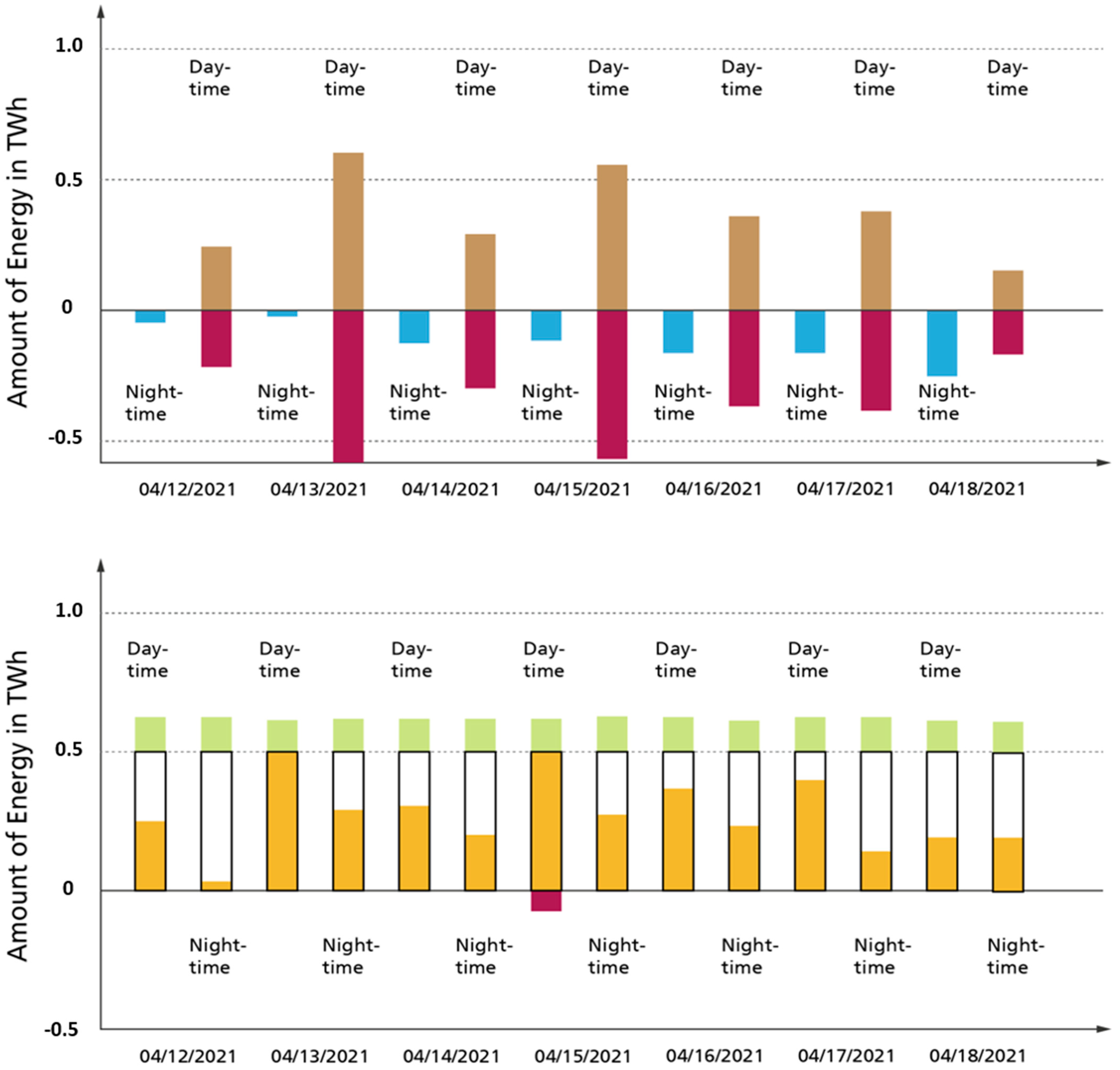
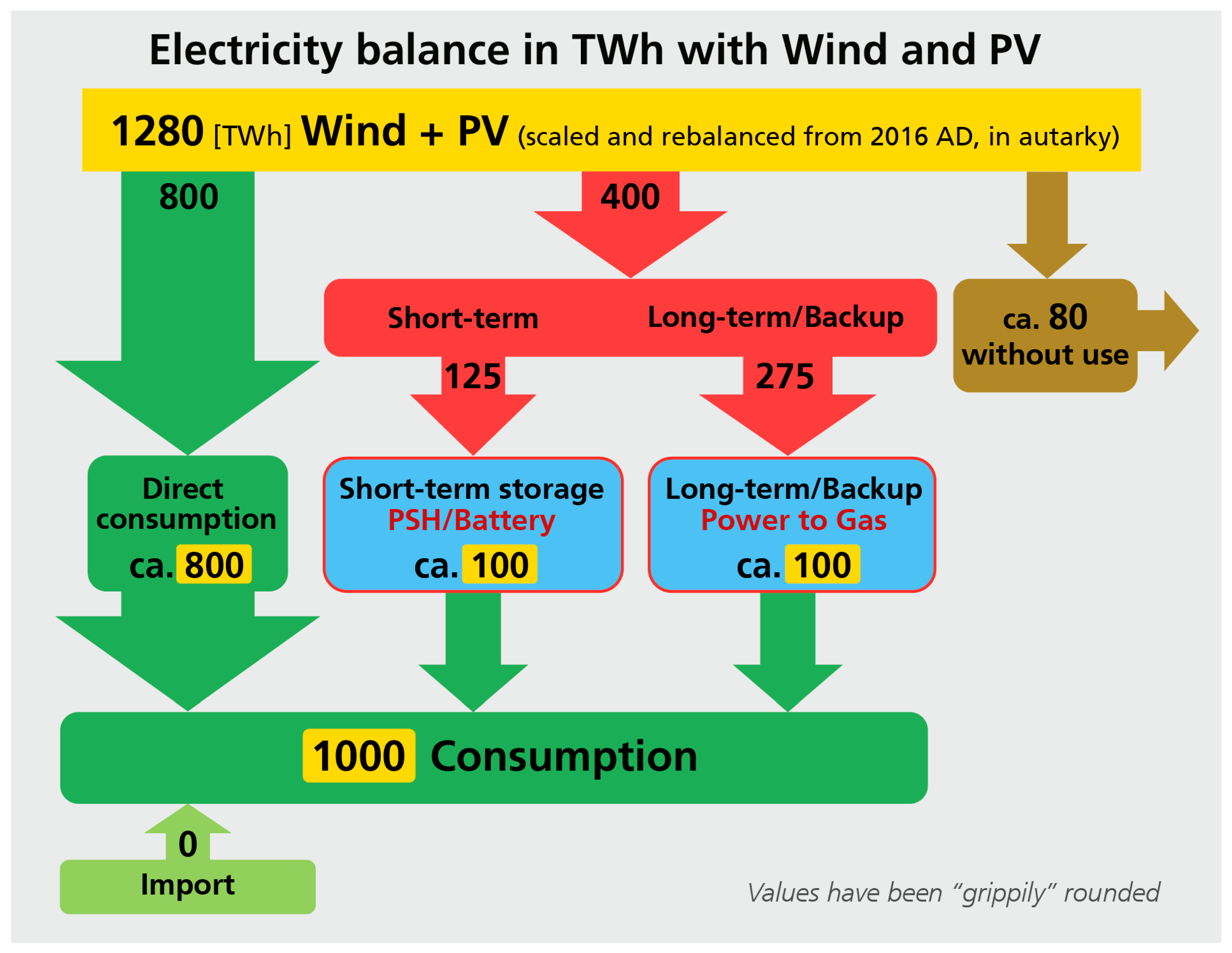
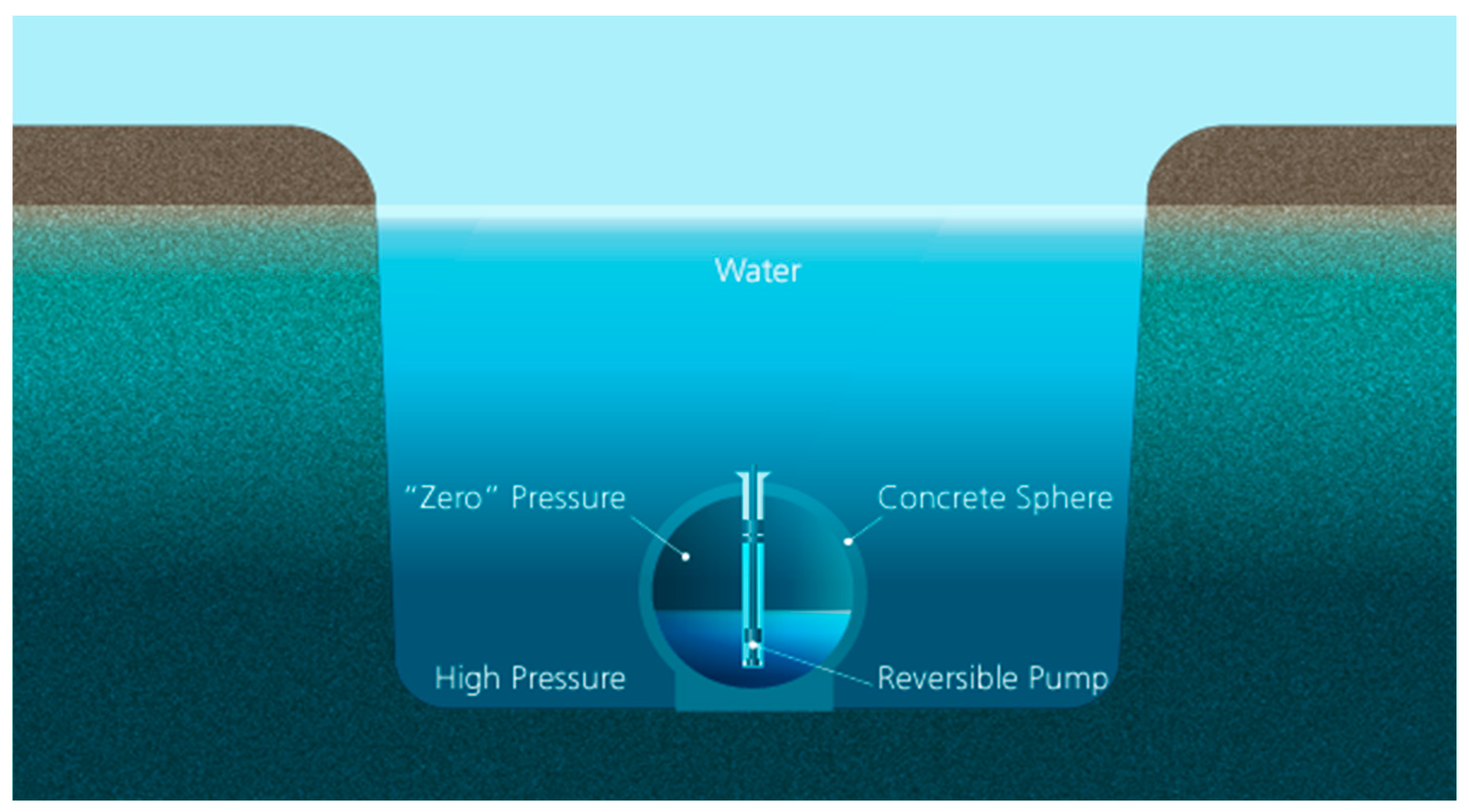
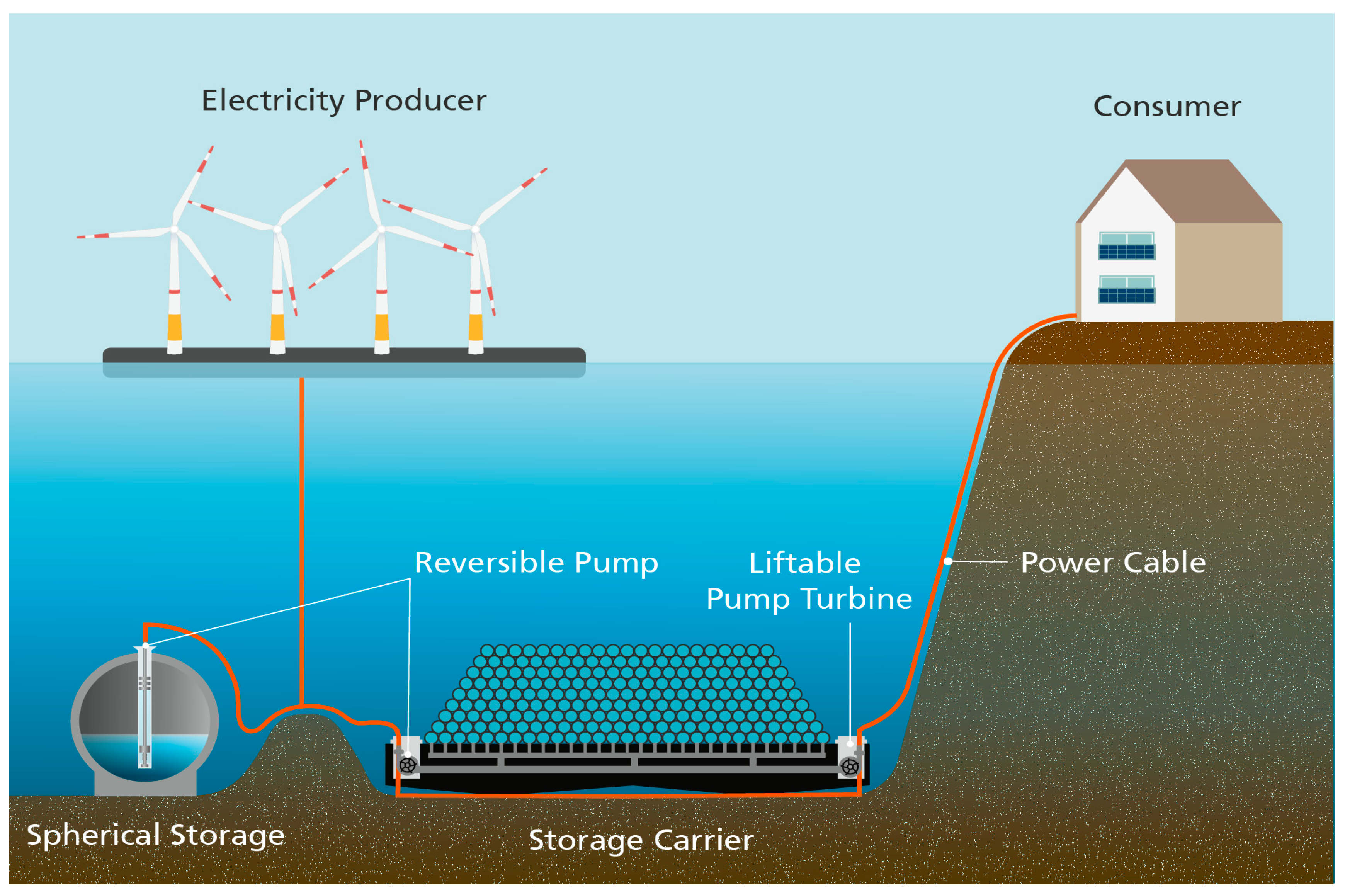
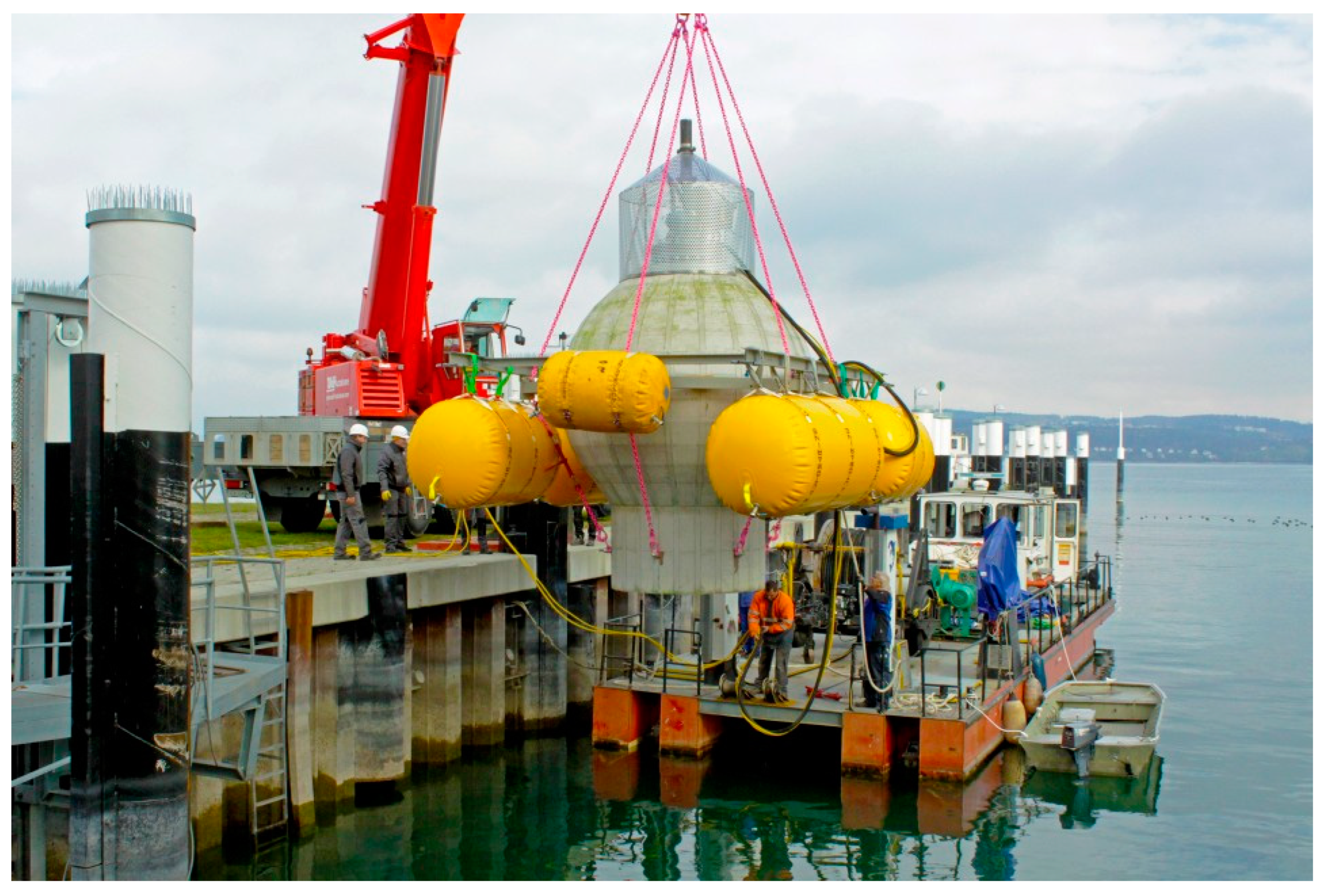
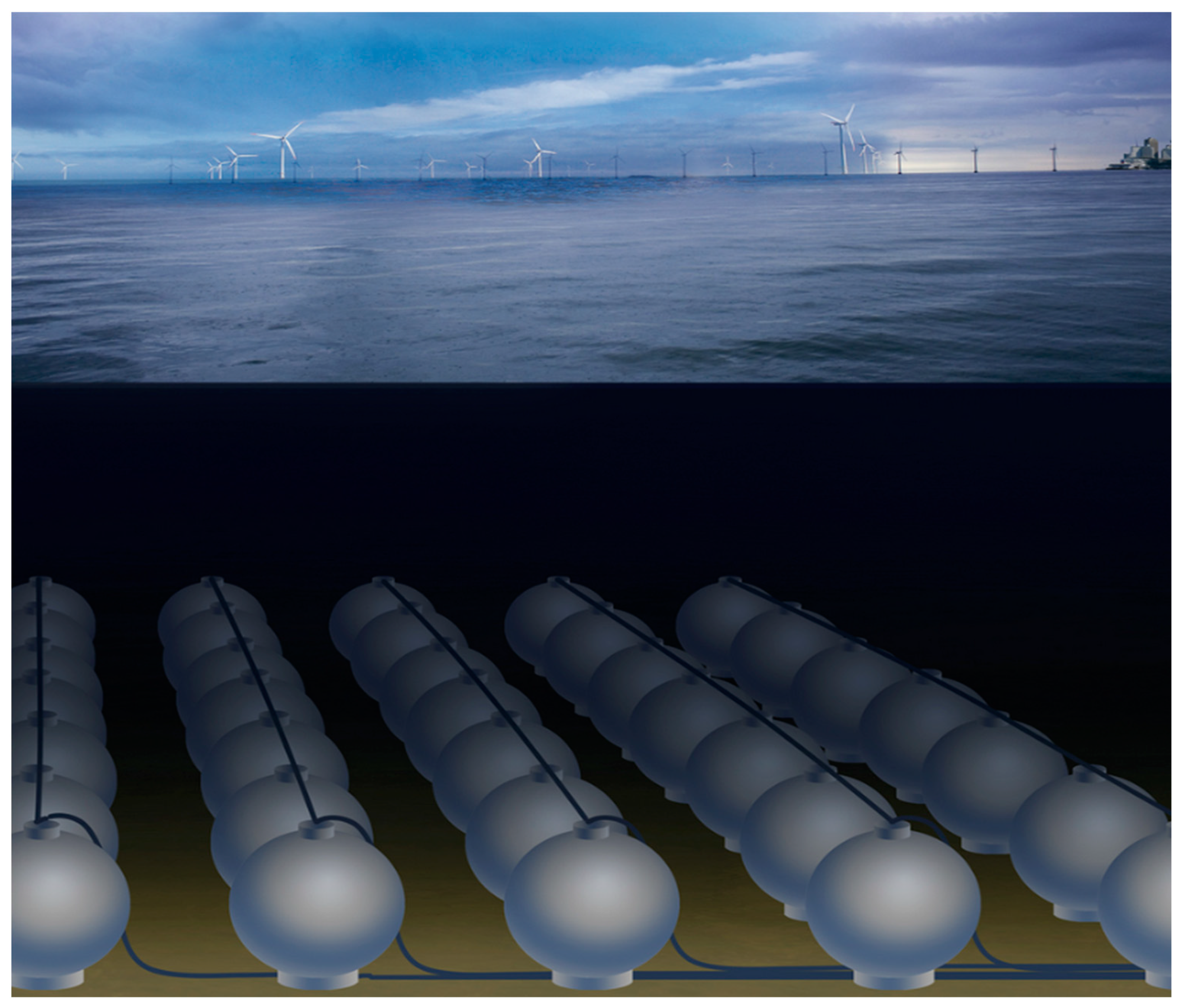
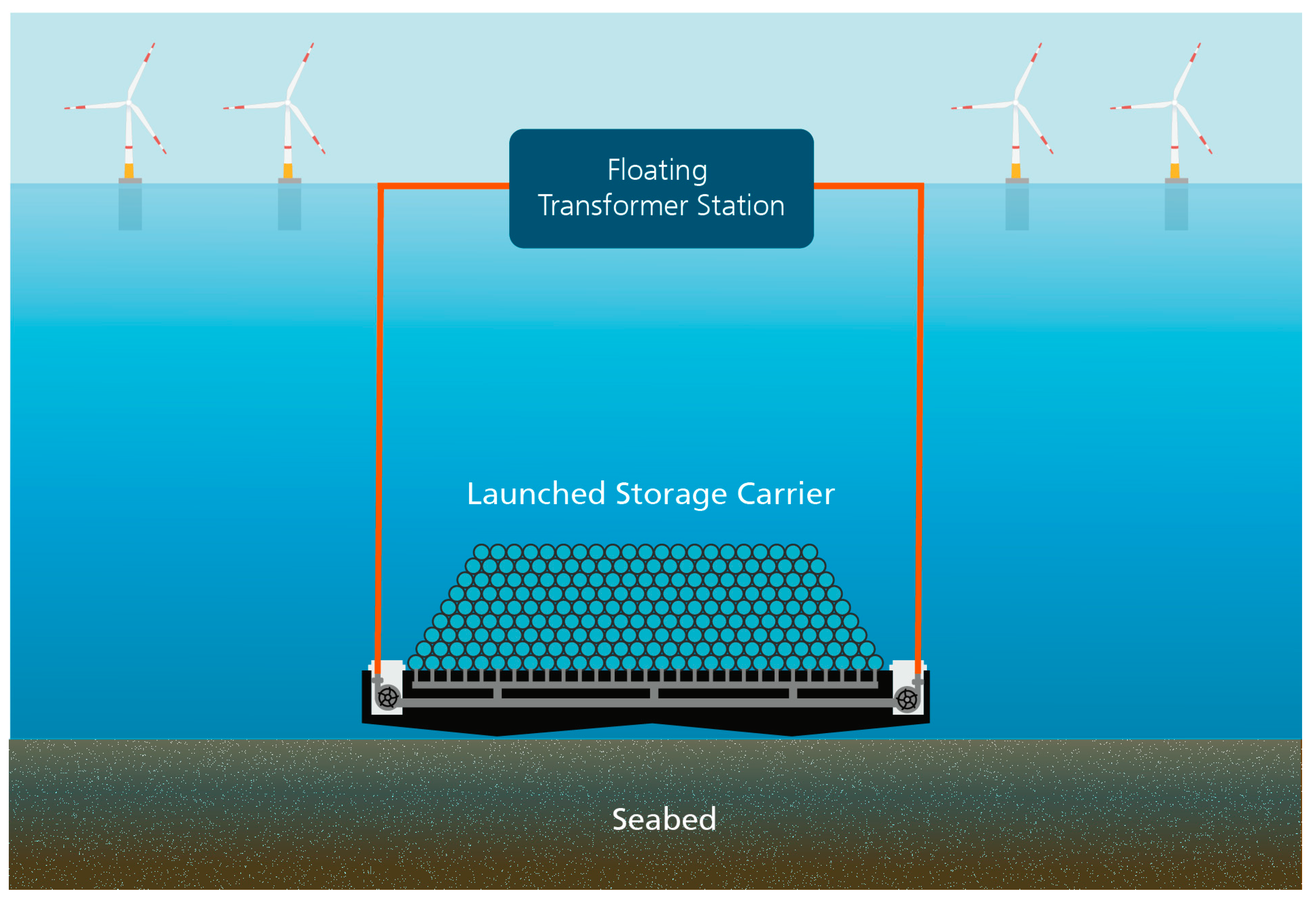




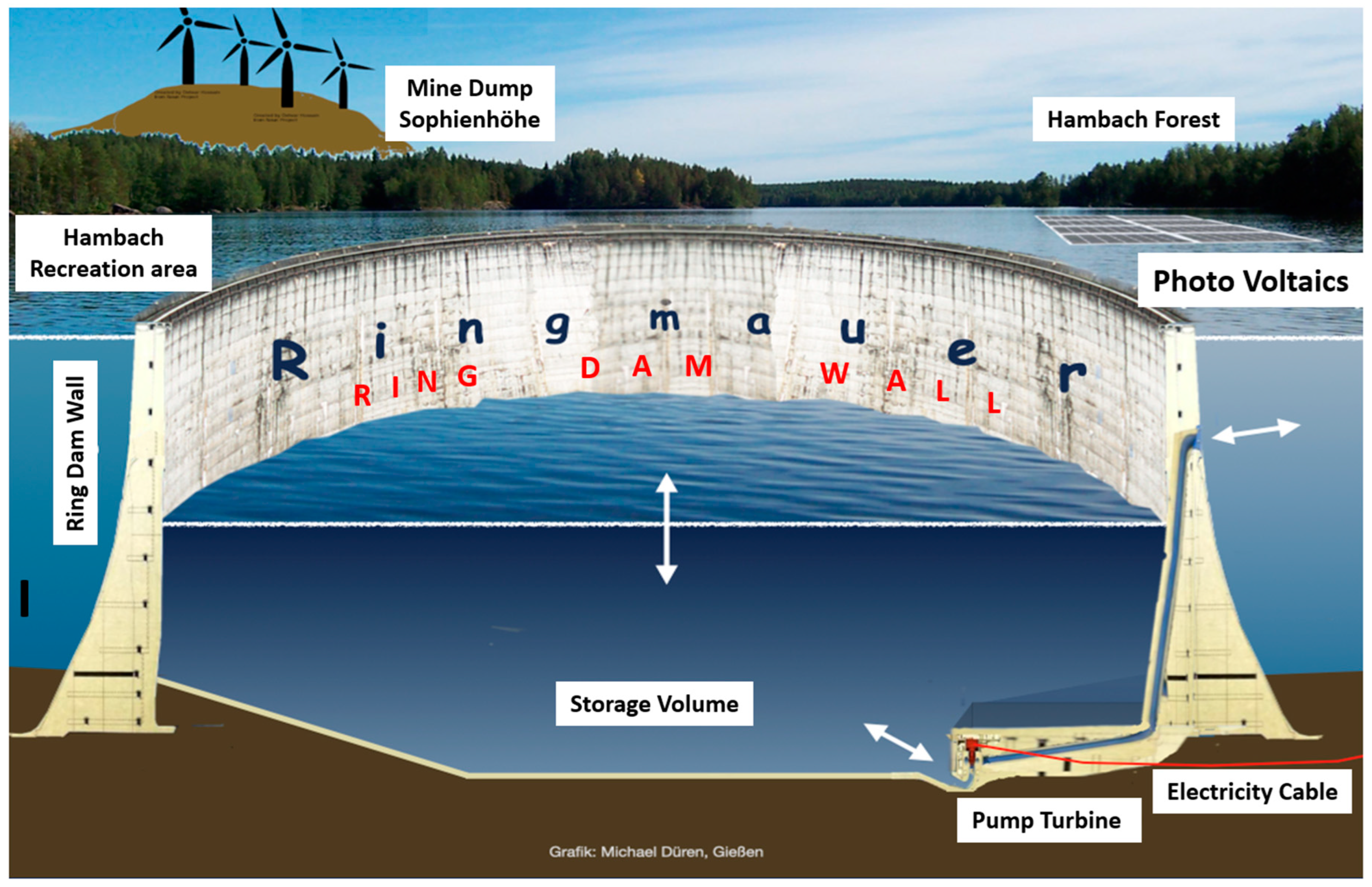
Disclaimer/Publisher’s Note: The statements, opinions and data contained in all publications are solely those of the individual author(s) and contributor(s) and not of MDPI and/or the editor(s). MDPI and/or the editor(s) disclaim responsibility for any injury to people or property resulting from any ideas, methods, instructions or products referred to in the content. |
© 2023 by the authors. Licensee MDPI, Basel, Switzerland. This article is an open access article distributed under the terms and conditions of the Creative Commons Attribution (CC BY) license (https://creativecommons.org/licenses/by/4.0/).
Share and Cite
Schmidt-Böcking, H.W.; Luther, G.; Düren, M.; Puchta, M.; Bender, T.; Garg, A.; Ernst, B.; Frobeen, H. Renewable Electric Energy Storage Systems by Storage Spheres on the Seabed of Deep Lakes or Oceans. Energies 2024, 17, 73. https://doi.org/10.3390/en17010073
Schmidt-Böcking HW, Luther G, Düren M, Puchta M, Bender T, Garg A, Ernst B, Frobeen H. Renewable Electric Energy Storage Systems by Storage Spheres on the Seabed of Deep Lakes or Oceans. Energies. 2024; 17(1):73. https://doi.org/10.3390/en17010073
Chicago/Turabian StyleSchmidt-Böcking, Horst Werner, Gerhard Luther, Michael Düren, Matthias Puchta, Tom Bender, Andreas Garg, Bernhard Ernst, and Heinz Frobeen. 2024. "Renewable Electric Energy Storage Systems by Storage Spheres on the Seabed of Deep Lakes or Oceans" Energies 17, no. 1: 73. https://doi.org/10.3390/en17010073
APA StyleSchmidt-Böcking, H. W., Luther, G., Düren, M., Puchta, M., Bender, T., Garg, A., Ernst, B., & Frobeen, H. (2024). Renewable Electric Energy Storage Systems by Storage Spheres on the Seabed of Deep Lakes or Oceans. Energies, 17(1), 73. https://doi.org/10.3390/en17010073








